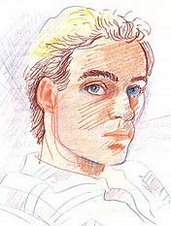 |
| Art created from sketches by O. Douglas Jennings enhanced with FOTOR AI program. |
Comparison Between the Greek God Dionysus & Jesus of Galilee
The comparison between the Greek god Dionysus and Jesus of Galilee has been a topic of scholarly interest for many years. The discussion revolves around similarities in their stories, attributes, and the roles they played in their respective religious traditions. Here are some of the key points of overlap and connection:
Similarities in Their Stories and Roles
1. Divine Birth:
Dionysus: Dionysus was born of a mortal woman, Semele, and the king of the gods, Zeus. This union gave Dionysus a semi-divine status, as he was both human and divine. -
Jesus: Jesus was born of a mortal woman, Mary, and God, according to Christian belief. His conception is said to be by the Holy Spirit, making him both human and divine.
2. Death and Resurrection: - Dionysus: In some versions of his myth, Dionysus is killed and then resurrected. For instance, the Orphic tradition tells of Dionysus being torn apart by Titans and later resurrected by Zeus. - Jesus: The central tenet of Christianity is the death and resurrection of Jesus. He was crucified, died, and rose again on the third day, according to Christian scripture.
3. Role as a Savior: - Dionysus: Dionysus is often seen as a god who brings joy, liberation, and salvation. His followers believed that through ecstasy and divine intoxication, they could be liberated from the mundane world. - Jesus: Jesus is viewed as the Savior in Christianity, offering salvation and eternal life to his followers. His teachings promise liberation from sin and spiritual rebirth.
4. Miracles: - Dionysus: Known for performing miracles, Dionysus could transform water into wine, make the earth produce fruit, and perform acts that defy natural laws. - Jesus: In the New Testament, Jesus performs similar miracles, such as turning water into wine at the wedding at Cana, feeding the multitude, and healing the sick.
5. Followers and Celebration: - Dionysus: Followers of Dionysus participated in rituals and celebrations known as Bacchanalia, which involved wine, music, and ecstatic dance. These rituals were seen as a way to commune with the divine. - Jesus: Christians celebrate Jesus’ life and teachings through rituals such as the Eucharist (Communion), which involves the symbolic consumption of wine and bread as the blood and body of Christ.
6. Symbolism of Wine: - Dionysus: As the god of wine, Dionysus is closely associated with vineyards and the production of wine, which symbolizes joy, celebration, and divine intoxication. - Jesus: Wine is a significant symbol in Christianity, representing Jesus’ blood during the Last Supper and communion, symbolizing the new covenant and spiritual nourishment.
Scholarly Perspectives
-Syncretism: Some scholars argue that the similarities between Dionysus and Jesus might result from syncretism, where elements of different religious traditions blend together. This was common in the Hellenistic world, where Greek and Eastern traditions often merged.
- Cultural Influence: The spread of Hellenistic culture and religion might have influenced early Christian thought. As Christianity emerged in a predominantly Greco-Roman world, it’s possible that stories and attributes of gods like Dionysus found their way into Christian narratives.
- Mystery Religions: Both Dionysus and Jesus have connections to mystery religions, which were popular in the ancient world. These religions promised initiates special knowledge and communion with the divine, often involving secretive rites and teachings about life, death, and rebirth.
Differences Despite the similarities, there are significant differences between Dionysus and Jesus:
1. Nature of Worship: - Dionysus: Worship often involved physical intoxication, revelry, and ecstatic states. It was a more chaotic and frenzied form of worship. - Jesus: Christian worship is generally more structured, focusing on prayer, teachings, and moral living.
2. Ethical Teachings: - Dionysus: Primarily associated with nature, ecstasy, and the cycles of life and death, Dionysus did not provide a specific ethical or moral code. - Jesus: Central to Jesus’ role is his ethical teachings, which include love, forgiveness, and moral behavior as outlined in the Sermon on the Mount and other scriptures.
3. Purpose and Mission: - Dionysus: Dionysus is a god of liberation and celebration, embodying the duality of joy and madness. - Jesus: Jesus’ mission is described as offering salvation, teaching about the Kingdom of God, and fulfilling prophecies from Jewish scriptures.
Conclusion: While there are intriguing parallels between Dionysus and Jesus, they ultimately serve different roles within their respective religious contexts. The similarities may highlight the ways in which human cultures create religious figures that address universal themes of life, death, and the divine. However, the unique elements of each figure underscore the distinct paths that Greek and Christian traditions have taken in their religious narratives.
Worth mentioning: I get the sense that in their respective cultures (Greek and Jewish) both Dionysus and Jesus acted, in many was, as “chaos agents” that upset the entrenched static and stagnant societal order.
More info from Mythology Info Stack Exchange
This blog entry text was created with the help of Chat GPT
Illustration Production Notes:
I created a concept sketch (upper left) and made an initial enhancement with FOTOR to refine the sketch (upper right). Then I applied a stained-glass filter to the sketch for a Jesus face (lower left) and separately applied a water color filter for the Dionysus version. Afterwards, I combined them in Photoshop Beta and used that program's Generative AI tool to create grapes in respective styles, a crown of thorns for Jesus and a communion chalice for the final illustration.






No comments:
Post a Comment